
Wednesday, June 27, 2012
States of matter
In the previous post I noted how most electricity is generated by the action of turbines transforming mechanical energy into electricity. By far the bulk of those turbines are driven by the motion of steam. Matter exists in three states - solid, liquid and gas. In the solid state the molecules are standing relatively still, in fixed position relative to each other. As such, a solid has both fixed shape and volume. As heat is added, the molecules will vibrate faster and faster, until they reach the point where the energy of the vibration overcomes the forces between the molecules that hold them together, and the molecules slip past each other. This is melting. In the liquid phase, the molecules are still all touching each other, so the volume stays the same, but the shape is variable (that is, when you pour water into a square container, it takes a square shape, but if you pour the same water into a round container it takes a round shape). Now here's the important part for our electricity story: as you add heat to a liquid, eventually the molecules move so quickly they break apart all together and go flying into the air. This is boiling. Since the molecules are not touching in the gas phase, the volume of a gas is variable. As you add heat to a gas, it expands. If you start with liquid water and heat it to boiling, the expanding gas can be directed past a turbine, and the movement of this turbine is what is then used to make electricity. More on the sources of heat tomorrow, but let's give a LEGO representation of the states of matter. After the first and second graders in the Marvelous Multiagers blogger's class had a lesson on the states of matter, some of them created a LEGO version during their playtime. As the teacher describes it, "The big white part is ice. There is a little blue because it's melting a little bit, haha. The big blue part is water. The little white part is a chimney with air coming out of it! We had just talked about how the heating or cooling can change the state of matter, so this really made my day!!". Quick aside - it's pretty much impossible to find a good LEGO image for steam. When you do searches you just come up with train engines and steampunk creations.


Friday, June 22, 2012
Electricity
When you plug your computer, or anything else, into the wall socket, it is extremely probable that the electricity coming through was produced by some sort of electric generator. There are various types, and I'll ignore the differences between AC and DC generators, but all of these depend on a couple of important scientific principles - the conservation of energy and Faraday's law of induction. The conservation of energy states that energy is neither created nor destroyed, but simply changes form. For instance, if I lift the pencil on my desk into the air, my muscles are converting chemical energy from the food I ate into raising the potential energy of the pencil. If I let go of the pencil, that potential energy changes into kinetic energy as the pencil falls. When it hits the desk, you hear the sound, which comes from the kinetic energy of the pencil being converted to the vibrations in the desk and then the air. BTW, this demonstration is much more effective in class if you use a heavy textbook, which tends to wake up dozing freshmen. :) In an electrical generator, the kinetic energy of a spinning turbine (more on what makes that spin in future posts) is transformed into electric current. This is due to electromagnetic induction. In 1931, Faraday described how the motion of a wire relative to a magnetic field leads to a movement of electrons in that wire. If the wire is wrapped around a spinning core between the poles of a magnet (or this can also work if the magnet is doing the spinning).
Redearth76 built this generator using LEGO, neodymium magnets and 30 & 22 gauge wire. He measured 13 volts on the 30 gauge side and 1 volt on the 22 gauge side. He also notes that this is an AC generator, and the LED flashes different colors when positive and negative current is applied, so it blinks back and forth.
Here's another version by goldenbat007
Finally, for a purist version, electric motors work on the reverse of this principle. Instead of using the spinning of an axle to produce an electric current, they use an electric current to produce the motion of an axle. Simple motors can also serve as electric generators, as seen here with a LEGO motor by danky78.
Redearth76 built this generator using LEGO, neodymium magnets and 30 & 22 gauge wire. He measured 13 volts on the 30 gauge side and 1 volt on the 22 gauge side. He also notes that this is an AC generator, and the LED flashes different colors when positive and negative current is applied, so it blinks back and forth.
Here's another version by goldenbat007
Finally, for a purist version, electric motors work on the reverse of this principle. Instead of using the spinning of an axle to produce an electric current, they use an electric current to produce the motion of an axle. Simple motors can also serve as electric generators, as seen here with a LEGO motor by danky78.
Saturday, June 16, 2012
Beautiful minds
LegoMachine1 built Beautiful minds:
"In honor of Sir Joseph Swan (1828-1914) and Thomas Alva Edison (1847-1931), the two men, which changed the way people live in homes around the world, inventing the incandescent light bulb. A bit of history: 'English Sir Joseph Wilson Swan in 1878 in Great Britain, patented the first light bulb ever made, but this, it proved impractical. The combustion system, was a thick filament carbon emitting gas, and very quickly, soot covered the interior of the bulb. Was then, the American Thomas Alva Edison, who in 1879 patented a high-strength thin filament, which did not emit gases. Swan also incorporated this improvement in his bulb, but was sued by Edison for patent infringement. In the end, common sense prevailed, Swan and Edison agreed, and in 1880, they created the Edison & Swan United Light Company. ..... and now light!"
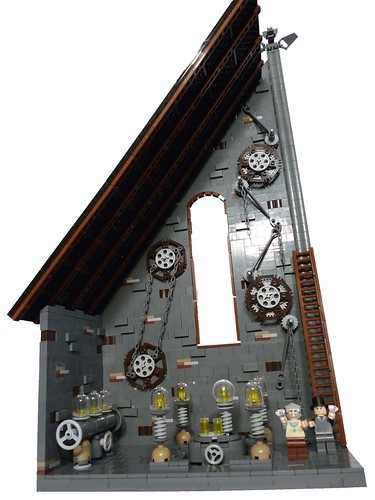
"In honor of Sir Joseph Swan (1828-1914) and Thomas Alva Edison (1847-1931), the two men, which changed the way people live in homes around the world, inventing the incandescent light bulb. A bit of history: 'English Sir Joseph Wilson Swan in 1878 in Great Britain, patented the first light bulb ever made, but this, it proved impractical. The combustion system, was a thick filament carbon emitting gas, and very quickly, soot covered the interior of the bulb. Was then, the American Thomas Alva Edison, who in 1879 patented a high-strength thin filament, which did not emit gases. Swan also incorporated this improvement in his bulb, but was sued by Edison for patent infringement. In the end, common sense prevailed, Swan and Edison agreed, and in 1880, they created the Edison & Swan United Light Company. ..... and now light!"

Friday, June 15, 2012
Pegusus XL
Apojove made the Pegasus XL rocket, which is launched from an airplane at high altitude to carry small payloads into orbit.


Thursday, June 14, 2012
Impossible objects explained
I occasionally draw something like this on the board and ask my students what it is:

When they reply 'a cube' I correct them, saying that it is a two dimensional drawing that uses tricks of perspective that our mind interprets as a three dimensional cube. Two dimensional drawings of impossible objects take advantage of these tricks of perspective, but the tricks don't match up. So if you cover up one part of the drawing and then cover up the other part of the drawing, different sections appear to be going in different directions. For example, take the famous devil's fork:
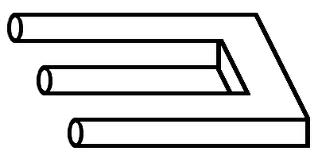
If you cover up the right-hand portion, you see three prongs, but if you cover the left portion you see two prongs. However, the lines connect up so at some point the three become two, or the foreground becomes the background. But how to achieve this in three dimensions? The whole idea of an impossible object is that it is impossible. The answer, of course, is that you can only see these from one particular point of view. If you were to look at them from any other angle, you would see that the edges don't match up. For instance ...
Brixe63's Terrace.
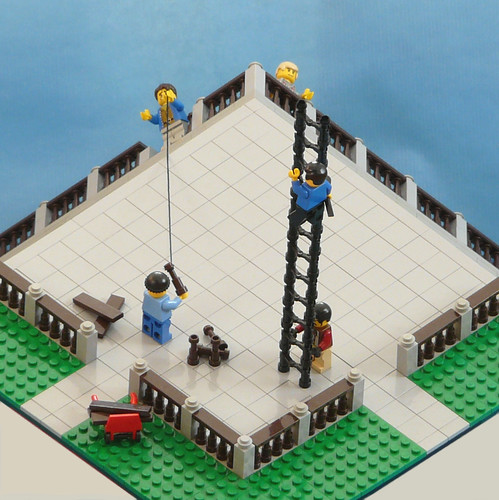

Legohaulic's Nightmare.


Henry Lim's Ascending and Descending.


Andrew Lipson and Daniel Shiu's Belvedere.



When they reply 'a cube' I correct them, saying that it is a two dimensional drawing that uses tricks of perspective that our mind interprets as a three dimensional cube. Two dimensional drawings of impossible objects take advantage of these tricks of perspective, but the tricks don't match up. So if you cover up one part of the drawing and then cover up the other part of the drawing, different sections appear to be going in different directions. For example, take the famous devil's fork:

If you cover up the right-hand portion, you see three prongs, but if you cover the left portion you see two prongs. However, the lines connect up so at some point the three become two, or the foreground becomes the background. But how to achieve this in three dimensions? The whole idea of an impossible object is that it is impossible. The answer, of course, is that you can only see these from one particular point of view. If you were to look at them from any other angle, you would see that the edges don't match up. For instance ...
Brixe63's Terrace.


Legohaulic's Nightmare.


Henry Lim's Ascending and Descending.


Andrew Lipson and Daniel Shiu's Belvedere.


Wednesday, June 13, 2012
Impossible objects
Several of the Escher illustrations depicted over the past few days are impossible objects - two dimensional drawings that seem to be of three dimensional objects, but turn out to be optical illusions, unbuild-able in real life. One of the first impossible objects, and one of the inspirations for Escher's Waterfall and other works, is known as the Penrose triangle. This was actually first depicted by Oscar Reutersvärd in 1934, before Roger Penrose independently presented his version.
The Penrose Triangle was the basis for the Lugnet logo. Lugnet was one of the first major LEGO websites.

John Langrish made this mosaic of the Lugnet Logo.

The Penrose Triangle has been recreated in LEGO many times. Some of these depend on Photoshop trickery, but others are true three-dimensional creaions, such as this by Billy Baldwin.

Brixe63's Modulex version is more remniscent of Reutersvärd's original design.

Various other LEGO impossible objects have been built, such as Don Solo's archway.
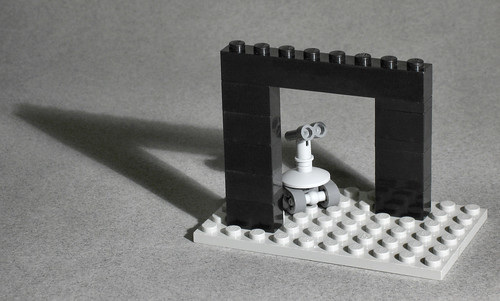
Brixe63 has had great fun with the idea in her set of optical illusions.
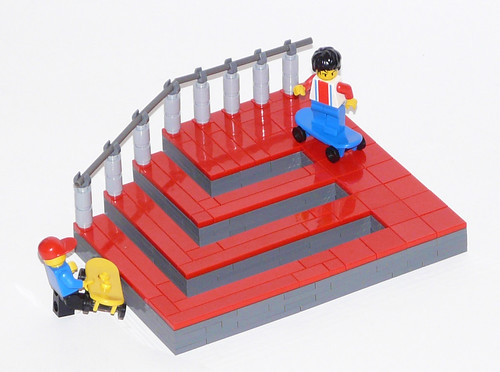

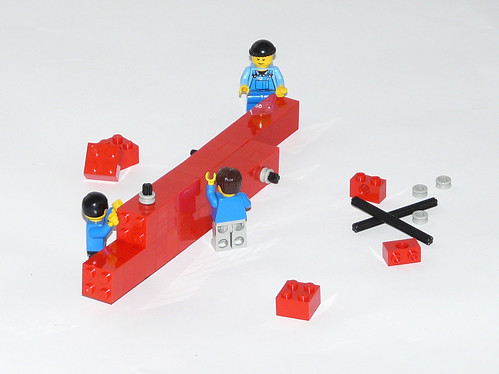
Brixe63 also has this amazing Terrace, that is based on an impossible scene that was apparently first used by Sandro del Prete (who was influenced by Escher).

The Penrose Triangle was the basis for the Lugnet logo. Lugnet was one of the first major LEGO websites.

John Langrish made this mosaic of the Lugnet Logo.

The Penrose Triangle has been recreated in LEGO many times. Some of these depend on Photoshop trickery, but others are true three-dimensional creaions, such as this by Billy Baldwin.

Brixe63's Modulex version is more remniscent of Reutersvärd's original design.

Various other LEGO impossible objects have been built, such as Don Solo's archway.

Brixe63 has had great fun with the idea in her set of optical illusions.



Brixe63 also has this amazing Terrace, that is based on an impossible scene that was apparently first used by Sandro del Prete (who was influenced by Escher).

Tuesday, June 12, 2012
More Escher roundup
Other Escher works have also been recreated in LEGO form, including ...
Day and Night by BrickWares.
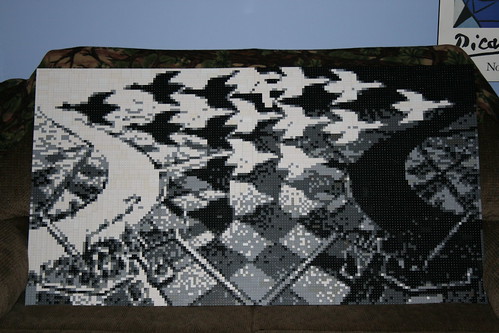
Balcony by Andrew Lipson and Daniel Shiu

Drowned Cathedral by Minkowsky
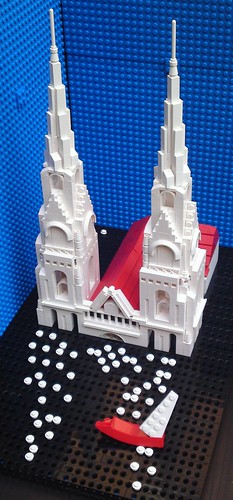
Sky and Water I seen at Legoland

Reptiles by Profound Whatever
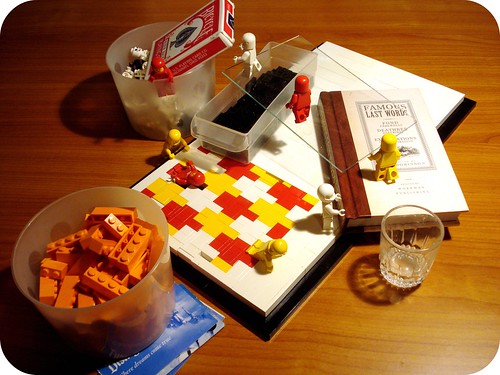
Double Planetoid at the Billund airport
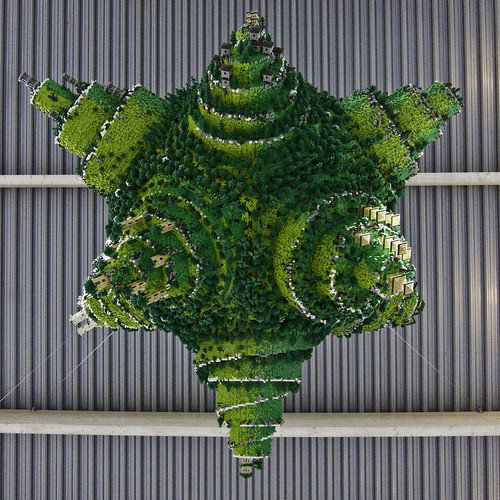
Three Spheres II by Gwaehur

Rose by Aaron K

Drawing Hands by Ian Leino
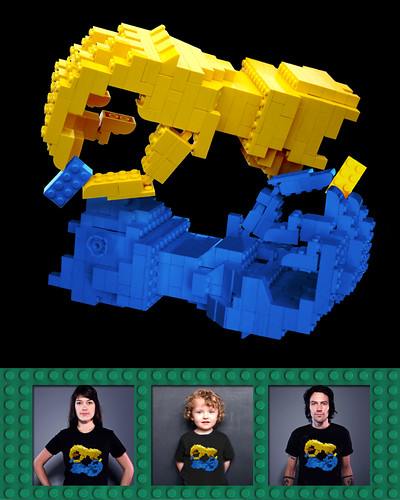
... and by Littlehorn

... and by B.K.

... and by j p

Day and Night by BrickWares.

Balcony by Andrew Lipson and Daniel Shiu

Drowned Cathedral by Minkowsky

Sky and Water I seen at Legoland

Reptiles by Profound Whatever

Double Planetoid at the Billund airport

Three Spheres II by Gwaehur

Rose by Aaron K

Drawing Hands by Ian Leino

... and by Littlehorn

... and by B.K.

... and by j p

Monday, June 11, 2012
Escher: Waterfall
A few takes on Escher's 'Waterfall':
Andrew Lipson and Daniel Shiu.

Henry Lim.

Jung von Matt advertising agency.

Legohaulic's Nightmare drew inspiration from Waterfall.

Andrew Lipson and Daniel Shiu.
Henry Lim.

Jung von Matt advertising agency.

Legohaulic's Nightmare drew inspiration from Waterfall.

Sunday, June 10, 2012
Escher: Belvedere
Belvedere has been another subject for LEGO Escher fans.
Andrew Lipson and Daniel Shiu.

Henry Lim.

Jung von Matt ad agency.

Brixe63, who has done a number of optical illusions, made some Belvedere-inspired bunk beds.

Andrew Lipson and Daniel Shiu.

Henry Lim.

Jung von Matt ad agency.

Brixe63, who has done a number of optical illusions, made some Belvedere-inspired bunk beds.

Saturday, June 9, 2012
Escher: Ascending and Descending
Continuing with our look at M.C. Escher in LEGO form, another very popular work is Ascending and Descending:
Probably the earliest version was by Andrew Lipson and Daniel Shiu.

Henry Lim's version.

The advertising agency Jung von Matt made a "create the impossible" ad.
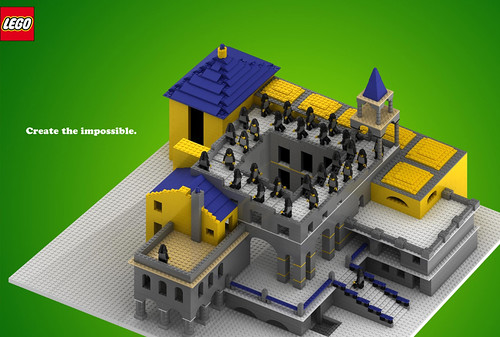
Puriri deVry.

Buge Fun.

Raphael Heusser.

Probably the earliest version was by Andrew Lipson and Daniel Shiu.

Henry Lim's version.

The advertising agency Jung von Matt made a "create the impossible" ad.

Puriri deVry.

Buge Fun.

Raphael Heusser.

Friday, June 8, 2012
Escher: Relativity
M.C. Escher is surely the most popular artist among mathematicians and scientists. His explorations of symmetry and tricks of perspective and perception and his playful use of geometry all explore themes that are important across all of these fields. Several LEGO builders have taken on Escher themes. The first prominent effort was by Andrew Lipson and Daniel Shiu, who recreated five different Escher works in the early 2000's. In 2005, Henry Lim was commissioned by the Hong Kong Science Museum to make his own takes on four Escher pictures. Others have explored this work in LEGO form as well.
Perhaps the most popular Escher work in LEGO form is Relativity. Here is a version by Andrew Lipson and Daniel Shiu.

And another by Henry Lim.

Paul Vermeesh just recently posted a Star Wars version (which is what prompted this post).

Profound Whatever did a space version.

NewRight did a castle version.

Here's a version by Supernerd23
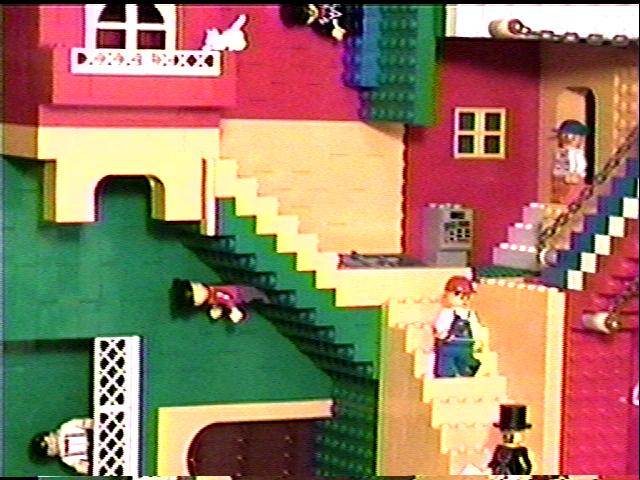
Big Daddy Nelson built this vignette

Thanks to Nannan of the Brothers-Brick for tracking down a couple of those links.
Perhaps the most popular Escher work in LEGO form is Relativity. Here is a version by Andrew Lipson and Daniel Shiu.

And another by Henry Lim.

Paul Vermeesh just recently posted a Star Wars version (which is what prompted this post).

Profound Whatever did a space version.

NewRight did a castle version.

Here's a version by Supernerd23

Big Daddy Nelson built this vignette

Thanks to Nannan of the Brothers-Brick for tracking down a couple of those links.
Subscribe to:
Comments (Atom)